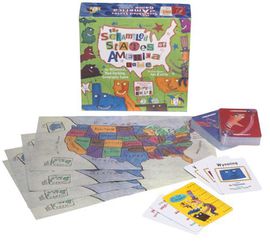Cheap Educational Toys, Best Learning Toys
Children are naturally inquisitive. Any parent who has successfully navigated the "why" phase will tell you that. Budget-smart educational toys channel kids' curiosity while teaching them something at the same time. Below are a few that stand out. This is but a sampling of the many quality, educational toys available for less than $20. These teaching toys appeal to both children's sense of exploration and parents' desire to see them succeed.
Our Top Pick


Mind Blowing Science Review
With a name like Mind Blowing Science (starting at $15, Amazon), Scientific Explorer gave its kit for young scientists a lot to live up to. Does it deliver on its promise? Well, Mind Blowing Science reviews indicate that mind blowing might be a stretch, but our child tester enjoyed doing the experiments and probing the world of "fun science."
This scientific kit for curious minds aged 4 to 8 can be viewed one of two ways. Some adults posting Mind Blowing Science reviews, like one disillusioned commenter on Fat Brain Toys, see it as a cheap collection of baking soda, cotton swabs, and boring experiments. Others, like a parent of a 5-year-old who also posted a review on Fat Brain Toys, see the kit as a simple but effective way to introduce inquisitive kids to the world of cause and effect. Most reviews subscribe to the second viewpoint, if the product's high ratings are to be believed. On Amazon, reviews average four stars out of five, based on a total of 72 reviews, and 60 posted reviews on Fat Brain Toys average nearly five out of five stars.
Our child expert, at 8 years old, was at the top end of the age bracket for this toy, so we wondered if she would be bored with the activities. That did not prove to be the case. During our Mind Blowing Science review, she was enthusiastic and proud as she demonstrated for us an underwater volcano eruption, and then showed off her test tubes of sunset-colored and jiggly crystals. Her only complaint was that the projects were messy, so she had to wear an apron to do them.
The Mind Blowing Science kit comes with detailed instructions for several experiments. It includes most of the items needed to conduct those experiments, such as goldenrod paper, test tubes, measuring scoops, swabs, stir sticks, and several child-safe chemicals, like corn starch, baking soda, and citric acid. Some additional household items, like flour and water, will also be needed. Although the experiments are appropriate for young children to conduct, adult supervision is required at all times.

Scrambled States of America Review
For those of us who struggled to memorize our state capitals in grade school, "geography" and "fun" are two words we might not put together in one sentence. After trying out Gamewright's card game The Scrambled States of America (starting at $12.50, Amazon), our 8-year-old toy tester felt differently. Her Scrambled States of America review turned up a winner.
This family-friendly game has players rush to collect as many state cards as they can by matching them up with "scramble" cards. Scramble cards may offer hints ranging from "State starts with a vowel" to "Capital has a person's first name hidden in it." Players can also win state cards by pairing them up with their closest neighbor state in "Going the Distance" rounds. To help even the playing field, each participant is given a map to guide them. While the manufacturer recommends this game for 8- to 12-year-olds, our tester's mom and dad enjoyed it just as much as their 8- and 10-year-old daughters did. Maybe more so, because they were delighted by its educational value.
Despite being rated for an older age group, Scrambled States of America reviews posted on Barnes & Noble say kids as young as 5, and sometimes younger, can play along with a little help from an adult or older child. One review on Epinions recommends making some minor changes to the rules to make the game more fun for little kids, while another review on Amazon suggests setting stricter rules to make it more challenging for teens. Although minor complaints pop up in reviews -- one heavy user wishes the paper maps were laminated to prevent ripping, and some could do without the sprinkling of non-geography questions -- most users loudly sing the praises of this game. A teacher's review on Amazon echoes that of several commenters who say kids not only love playing The Scrambled States of America, they have exponentially increased their knowledge of U.S. geography as a result.
For around $12, Scrambled States of America pleases a variety of age groups, travels well, and makes learning fun. Based on our experiences with our child toy tester, if family game night is your thing, this one is worth throwing into the mix.

Rainbow in My Room Review
Uncle Milton's Rainbow in My Room (starting at $19, Amazon) is a whimsical nightlight designed for any child who has ever dreamed of having their very own rainbow. The concept is simple. Turn it on in a dark room, and it projects a vivid LED rainbow onto the wall or ceiling. Depending which mode you choose, the rainbow will either appear all at once or by slowly adding the colors one at a time.
When we introduced this toy to our eight-year-old child tester for a Rainbow in My Room review, she immediately ran off to locate a dark space and put it to the test. The rainbow it projected was every bit as bright as you would expect from an LED device, and she was thrilled with the result. Based on our review, it was easy to picture it being a sleepover hit. We soon found out this wasn't our toy expert's first experience with the Rainbow in my Room, however. A few years prior, she had received one as a gift. She used it as her nightlight, and then woke up spooked one night in a pitch black room because its auto shut-off feature kicks in after 10 minutes.
Many parents posting Rainbow in My Room reviews on Walmart and Fat Brain Toys like that the auto shut-off feature conserves batteries. For those who want their light to shine through the night, this rainbow maker comes with an AC jack, although an AC adapter must be purchased separately. Another review on Fat Brain Toys says it was difficult to locate the correct adapter for the toy. Other negatives consumers point out in reviews are that it isn't sold with batteries (it requires three AA batteries) and the five LED light bulbs are difficult to replace once they burn out, as one parent laments in a review on Amazon.
For the most part, children seem to grow attached to the Rainbow in My Room. Many sleep with it every night and some even insist that it travel on vacation with them, notes one mother in a Rainbow in My Room review on Target.
Whether your young rainbow enthusiasts are scientists-in-the-making or dreamers with their heads in the clouds, Rainbow in My Room will appeal to their sense of imagination. It may not make a good primary nightlight for children afraid of the dark, however, given the10-minute auto shut-off. Available for a little less than $20, it's on the pricier side of the toys we typically review, but may be a good splurge gift when you're looking for something with the "wow" factor.

Ein-O's Human Brain Box Review
TEDCO Toys, known for its scientific and educational playthings, has put out a series of small, affordable box kits that cover a variety of topics. These science sets inform on and illustrate everything from crystal growing to chemistry to how motors work. We chose Ein-O's Brain Box Kit (starting at $9, Amazon), part of the human biology series, to try out with our young toy expert.
The kit itself is well-packaged in a clear plastic box that's roughly the size of a slice of bread, only much deeper. It consists of a colorful, 3-D anatomical model of the brain (assembly required) and Ein-O's I Know Guide, which provides a basic description of the anatomy of the brain and how each part functions. Our 8-year-old toy tester skipped over the guide completely and jumped right into assembling the brain model, using the packaging illustrations as a guide. She liked that the pieces were color-coded, but it threw her for a loop that the colors of the brain parts she received were different than the colors used on the packaging. The assembly process was more complex that you would think, partly due to unclear instructions, and eventually an adult was recruited to help put the brain together.
Even when the brain model was fully assembled, the pieces just sort of sat there in the provided tray, rather than fitting together securely, and fell apart easily when jostled. At that point the kit also lost all appeal for our tester. She commented that you "can't really play with it. It's a science kit for school or something."
Despite its failure as a traditional toy, Ein-O's Brain Box Kit is a simple way to educate young scientists about the anatomy of the brain by providing a hands-on experience. When used in conjunction with other materials, and with additional instruction from an adult, the human biology box kits help illustrate the body in a way a textbook can't. That said, this is not the kind of gift that's liable to elevate you to "cool" status in a child's mind (unless that child is president of the science club). Our recommendation: Skip these kits as gifts but keep them in mind as great visual aids when the science fair rolls around.

Science Wiz Electricity Review
Science Wiz Electricity (starting at $14, Amazon) is one of a series of elementary-level kits that introduce grade-schoolers to the basic concepts of the physical sciences. This kit comes with an illustrated book that demonstrates 18 electricity-related experiments and all of the materials required to conduct them, save one D-cell battery. Written by UC Berkeley biophysics Ph.D. Penny Norman, this title has won numerous awards and accolades. But will these cheap science experiments keep the child in your life entertained long enough to impart their knowledge? The short answer from our 8-year-old tester: yes. This Science Wiz kit kept her busy and fully absorbed, learning about circuits, lighting up bulbs, and operating simple motors. She couldn't wait to demonstrate her newfound skills to her siblings and quickly began to experiment on her own with ever more complex circuits.
While our tester had great fun spinning pinwheels and her own custom-colored designs using the enclosed motor, the kit wasn't perfect. The instructions warn that the buzzer and small LED light work only if the alligator clips are attached to the battery a certain way and advises switching the connections if you don't see results. Unfortunately, our LED light never functioned, and the buzzer worked only occasionally, and only after our tester poked the motor's prong into a small hole on top of the buzzer casing. This left our young reviewer able to complete only about half of the activities in the book. The flaky buzzer meant she had to skip one of the most intriguing experiments, which involves using the buzzer to communicate in Morse code. By the looks of one Science Wiz Electricity kit review on Amazon, we weren't the only ones who found that these parts wouldn't work. Another user who posted a review on Amazon discovered that the LED light needed the power of multiple D batteries to produce a visible light.
The Science Wiz Electricity kit is a fun way to introduce young kids to the basics of electricity. While the set claims to be for children 5 to 10 years old, we suspect it's a bit too simple for budding scientists at the top of that age range. Then again, an educator who posted a Science Wiz Electricity kit review on Amazon reports that the 7- to 10-year-olds in her after-school program were enthralled with this Science Wiz kit.



















